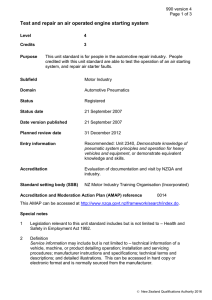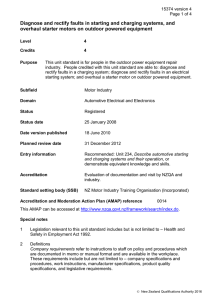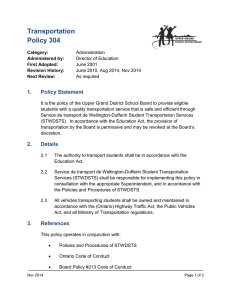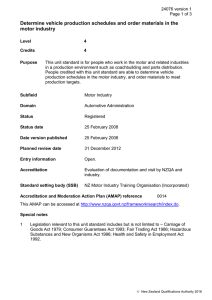Diagnose and rectify faults in marine charging and starting systems
advertisement
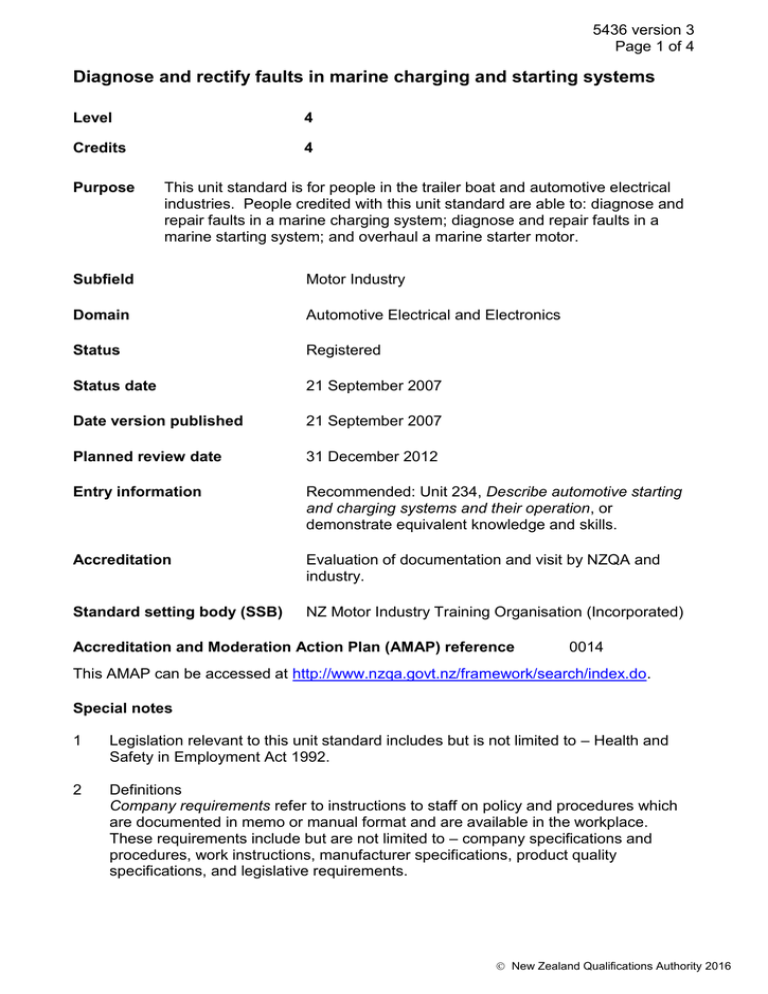
5436 version 3 Page 1 of 4 Diagnose and rectify faults in marine charging and starting systems Level 4 Credits 4 Purpose This unit standard is for people in the trailer boat and automotive electrical industries. People credited with this unit standard are able to: diagnose and repair faults in a marine charging system; diagnose and repair faults in a marine starting system; and overhaul a marine starter motor. Subfield Motor Industry Domain Automotive Electrical and Electronics Status Registered Status date 21 September 2007 Date version published 21 September 2007 Planned review date 31 December 2012 Entry information Recommended: Unit 234, Describe automotive starting and charging systems and their operation, or demonstrate equivalent knowledge and skills. Accreditation Evaluation of documentation and visit by NZQA and industry. Standard setting body (SSB) NZ Motor Industry Training Organisation (Incorporated) Accreditation and Moderation Action Plan (AMAP) reference 0014 This AMAP can be accessed at http://www.nzqa.govt.nz/framework/search/index.do. Special notes 1 Legislation relevant to this unit standard includes but is not limited to – Health and Safety in Employment Act 1992. 2 Definitions Company requirements refer to instructions to staff on policy and procedures which are documented in memo or manual format and are available in the workplace. These requirements include but are not limited to – company specifications and procedures, work instructions, manufacturer specifications, product quality specifications, and legislative requirements. New Zealand Qualifications Authority 2016 5436 version 3 Page 2 of 4 Service information may include but is not limited to – technical information of a vehicle, machine, or product detailing operation; installation and servicing procedures; manufacturer instructions and specifications; technical terms and descriptions; and detailed illustrations. This can be accessed in hard copy or electronic format and is normally sourced from the manufacturer. Suitable tools and equipment means industry approved tools and equipment that are recognised within the industry as being the most suited to complete the task in a professional and competent manner with due regard to safe working practices. 3 For this unit standard, it is essential that the practical assessment evidence is obtained in the workplace under normal workplace conditions. Elements and performance criteria Element 1 Diagnose and repair faults in a marine charging system. Performance criteria 1.1 Safe working practices are observed throughout the task in accordance with legislative requirements. Range personal safety, safety of others, equipment safety. 1.2 The engine is run and the symptoms of the fault(s) are identified in accordance with service information. 1.3 Suitable tools and test equipment are selected and used that enable the system to be diagnosed and repaired in accordance with service information. 1.4 A fully serviceable battery is used before continuing other charging system tests. 1.5 The charging system is tested following the engine manufacturer recommended testing procedure. 1.6 The servicing and testing procedures for solar powered systems are identified in accordance with service information. 1.7 Test results are recorded and faults isolated. Range wiring fault, battery supply, component fault. 1.8 Charging system components are removed from the engine in accordance with engine service information. 1.9 Parts are tested and faults rectified in accordance with service information. New Zealand Qualifications Authority 2016 5436 version 3 Page 3 of 4 Element 2 Diagnose and repair faults in a marine starting system. Performance criteria 2.1 Safe working practices are observed throughout the task in accordance with legislative requirements. Range personal safety, safety of others, equipment safety. 2.2 The starting system is operated and the symptoms of the fault(s) are identified in accordance with service information. 2.3 Suitable tools and test equipment are selected and used that enable the system to be diagnosed and repaired in accordance with service information. 2.4 A fully serviceable battery is used before continuing other starting system tests. 2.5 The starting system is tested following engine manufacturer recommended testing procedure. 2.6 Test results are recorded and faults isolated in accordance with service information. Range 2.7 wiring fault, battery supply, component fault. Starting system components are tested and faults rectified in accordance with service information. Range may include but is not limited to – outboard electric start; inboard pre-engaged or inertia starter; voltage supply circuit, voltage drop, connections, start switch, neutral switch, solenoid, starter motor engagement mechanism. Element 3 Overhaul a marine starter motor. Performance criteria 3.1 Safe working practices are observed throughout the task in accordance with legislative requirements. Range 3.2 personal safety, safety of others, equipment safety. Suitable tools and equipment are selected and used that enable the starter motor to be overhauled in accordance with service information. New Zealand Qualifications Authority 2016 5436 version 3 Page 4 of 4 3.3 The starter motor is removed from the engine in accordance with engine service information. 3.4 The starter motor unit is dismantled in accordance with service information. 3.5 All parts are cleaned to enable an inspection to be carried out in accordance with service information. 3.6 A condition report is completed and given to the supervisor in accordance with company requirements. Range 3.7 All parts that are determined to be replaced are procured in accordance with company requirements. Range 3.8 inspecting and testing parts, identifying and recording faults, recommending repairs and replacement of parts. interpreting the service information and/or parts catalogue, obtaining costs and delivery details, ordering parts. The starter motor is reassembled in accordance with service information. Range replacement of parts, repairs effected, clearances, lubrication. 3.9 The starter motor is refitted to the engine in accordance with service information. 3.10 The starter is operated to ensure system is functioning in accordance with service information. Please note Providers must be accredited by NZQA, or an inter-institutional body with delegated authority for quality assurance, before they can report credits from assessment against unit standards or deliver courses of study leading to that assessment. Industry Training Organisations must be accredited by NZQA before they can register credits from assessment against unit standards. Accredited providers and Industry Training Organisations assessing against unit standards must engage with the moderation system that applies to those standards. Accreditation requirements and an outline of the moderation system that applies to this standard are outlined in the Accreditation and Moderation Action Plan (AMAP). The AMAP also includes useful information about special requirements for organisations wishing to develop education and training programmes, such as minimum qualifications for tutors and assessors, and special resource requirements. Comments on this unit standard Please contact the NZ Motor Industry Training Organisation (Incorporated) janet.lane@mito.org.nz if you wish to suggest changes to the content of this unit standard. New Zealand Qualifications Authority 2016

